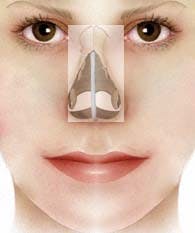
Deviated Nose
Crooked nose deformity

Why is a crooked nose deformity so difficult to fix?
Mainly because there are so many areas where tissues can relapse. Cartilage has memory and aggressive septoplasty techniques may be necessary including total septal excision and replacement.
What do you do for crooked nasal bones?
First of all, the surgeon needs to be able to properly analyze and examine the nasal bones. The nasal bones have a complex geometric structure, I termed the pyramidal frustrum (means truncated pyramid),. (Shah AR, et al. Aligning the Bony Nasal Vault in Rhinoplasty. Facial Plastic Surgery 2006; 22:003-08.) Essentially, you have two nasal bones. and a central bony septum (shown in pink). In order to straighten the nose, the surgeon must address each component of the deviation, which means to break the nasal bones and move over the bony septum.

Many surgeons do not believe in mobilization of the bony or central segment. (I am currently looking at its effects on nasal deviation in a cadaver study). However, if you do not mobilize this portion, how can you make something straight if it is crooked.
Is it risky to mobilize the bony septum?
Overaggresive manipulation can lead to collapse. Some patients are predisposed due to prior fractures and/or surgery. A surgeon must be prepared to correct this deformity. 1 report by a surgeon much older than me said that he had 6 cases in his career out of greater than 1372 noses. (Gunter JP, et al. Management of intraoperative fractures of the nasal septal “L-strut”: percutaneous Kirshner wire fixation. Plast Reconstr Surg 2006, Feb;117 (2):395-402.

I have had 5 cases of intraoperative fracture of the “L-strut” and believe it is a missed diagnosis by most surgeons. It is a more difficult problem to diagnose and correct. If not corrected it will lead to a depression between the bony and cartilaginous junction.
What is the key to correcting the crooked nose deformity?
The key is correcting the deviation of the septum. Even in noses which do not appear crooked externally, a slight deviation can manifest in a postoperative deviation if not addressed intraoperatively.



Figure 1. CT scan overlaying face demonstrating deviation of septum to the patient’s left. It is clear that the airway is compromised due to the position and shape of septum and size of the turbinates. Second image depicts septum with deviation to left, while last image depicts septum after correction with septoplasty.
Repairing the crooked nose is one of the more difficult challenges in rhinoplasty. Various parts of the nose can be asymmetrical or deviated which can lead to a crooked nose deformity including deviation of the nasal septum, nasal bones, or asymmetry of the lower lateral cartilage. Often times, crooked noses may have associated functional issues associated with them as well.
There are many nuances which can help make the chances of success and improved symmetry more likely. Surgeons who correct the crooked nose deformity well should have expertise in both septoplasty, rhinoplasty, and advanced rhinoplasty techniques.


